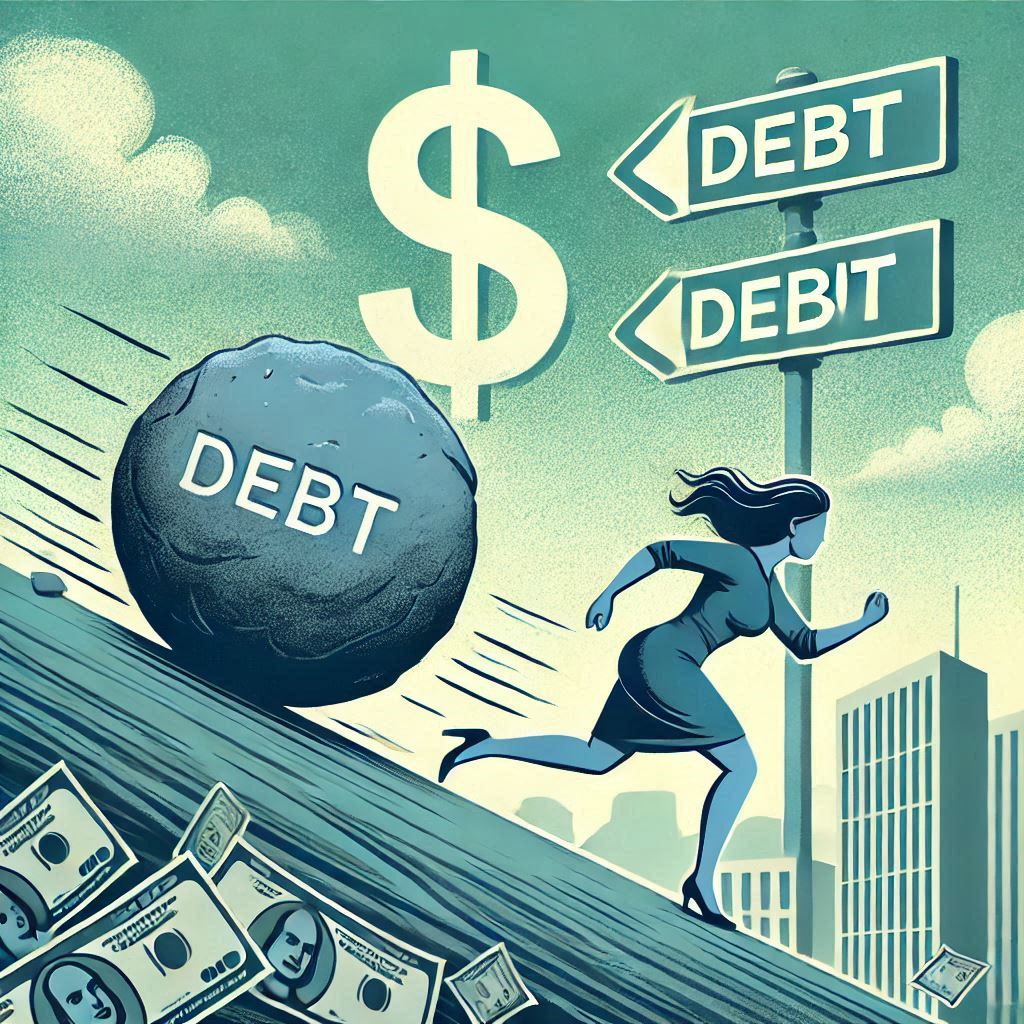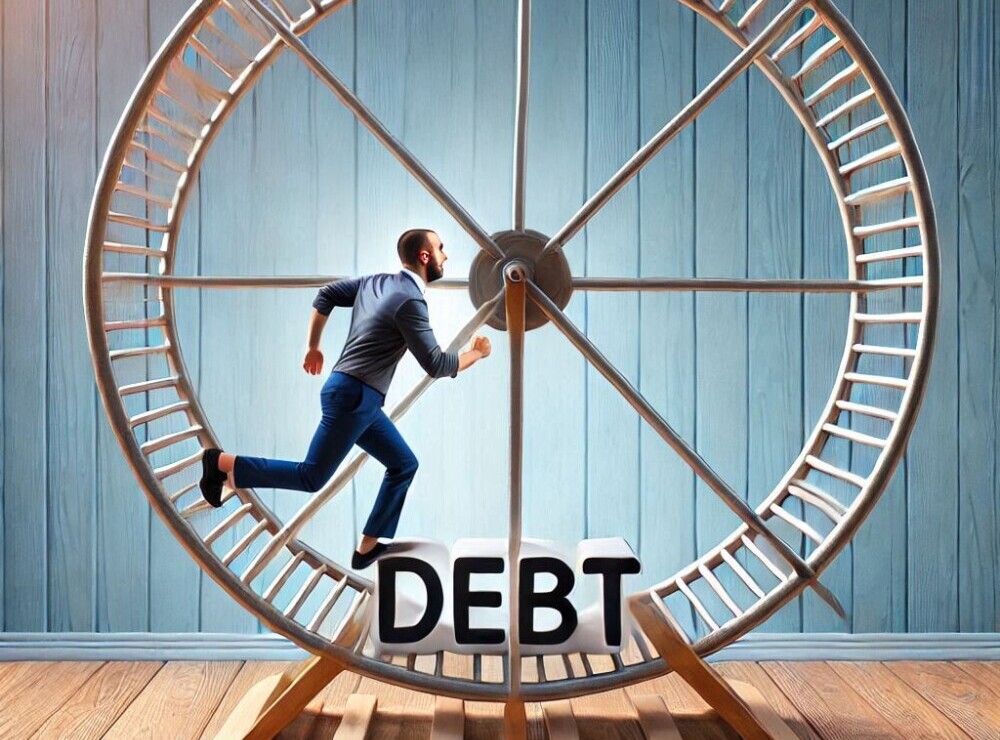How To Avoid The Debt Trap

So what’s the debt trap really? It’s a cycle, the kind that starts with a single credit card swipe and gradually turns into a juggling act with spiraling interest and fees. You’re borrowing from Peter to pay Paul, and suddenly, it feels like you’re sinking deeper with every repayment due.
It’s not just about the dollars; it’s the mental load that comes with it. Being in debt takes a toll beyond just your wallet. The pressure can be relentless, affecting everything from sleep to daily decisions, creating a fog that makes it hard to see a way out.
According to recent data from the Federal Reserve, American household debt is climbing past $14 trillion. Yes, trillion, with every American household holding an average of over $137,000 in debt. Over 12 million Americans use payday loans annually, often paying over $520 in fees for a typical $375 loan. This mountain of financial obligation is less about figures and more about the stories behind them—narratives of dreams, stress, and the slippery slope of borrowing.

Why should We Care about the Debt Cycle?
Because unless we’re armed with the right information and strategies, it’s easy to fall prey to financial illusions. Whether it’s that new car you couldn’t technically afford or the impulsive use of a credit card, the debt trap doesn’t discriminate, and it’s more common than you might think.
Getting smart with your money starts before you even sign that loan document. Financial literacy isn’t just for Wall Street bankers; it’s crucial for everyday folks like us, the backbone of this country. Knowing how interest rates stack up, the difference between good debt and bad debt, and how to spot a sneaky term or condition could make all the difference.
Set yourself up with a solid understanding now, and you’ll not only avoid the trap but also feel more in control of your financial destiny. Let’s shatter any misconceptions—being financially literate is your first line of defense.

The Invisible Chains: Why Debt Becomes a Trap
Debt isn’t just a burden you carry; it’s those hidden chains that seem to add weight over time. Imagine you’ve got a high-interest credit card—each time you make just a minimum payment, the interest is silently piling back on, often faster than you can pay it off. This is where the trap really tightens its grip: you pay and pay, but your balance never seems to quite go down. It’s like filling a bucket with a hole in it.
Then, there’s the lifestyle bit. The idea of spending tomorrow’s money today is engrained into our culture. The YOLO mentality, the thought that you can’t take the money with you when you die. Ads scream, ‘buy now, pay later,’ and it’s easy to fall for it. Before you know it, that paycheck is spread too thin, trying to catch up with yesterday’s impulses.
Debt is also about the company we keep. Seeing a friend or family member upgrade can lead to some serious FOMO (fear of missing out), or encourage the desire to spend money we don’t have. The wish to keep up can sometimes lead us straight into financial quicksand.
Awareness is key here. Recognizing these traps before they’ve got you shackled means you can make more mindful, strategic choices. Awareness breeds understanding, and understanding is power—especially when it comes to your finances.
Top 5 Debt Traps to Avoid in 2025
The holiday season and the time after, with its festive spirit and financial pressures, often leads many to spend beyond their means, especially during Christmas shopping. In the pursuit of providing gifts, hosting gatherings, or simply keeping up with holiday traditions, people sometimes turn to financial products that seem like quick fixes but can have devastating long-term consequences. Below are some of the most common debt traps individuals fall into, particularly when trying to manage the expenses of the season.
1. Payday Loans
- Why it’s a trap: These short-term loans come with extremely high interest rates (often exceeding 400% APR) and fees. Borrowers often roll over the loan, trapping them in a cycle of debt.
2. Rent-to-Own Agreements
- Why it’s a trap: While they offer the option to acquire furniture, electronics, or appliances without credit checks, the cumulative payments often far exceed the retail price of the item, leading to overpayment and financial strain.
3. Credit Card Cash Advances
- Why it’s a trap: Cash advances often have higher interest rates than regular purchases and incur immediate fees. They lack a grace period, leading to immediate interest accrual, quickly escalating debt.
4. Car Title Loans
- Why it’s a trap: These loans require using your vehicle as collateral and often come with triple-digit APRs. If the loan is not repaid, you risk losing your car, further exacerbating financial hardships.
5. Overdraft Protection
- Why it’s a trap: Marketed as a safety net for insufficient funds, this service can lead to hefty fees for each transaction beyond your balance. Repeated overdrafts can create a cycle of fees that is difficult to escape.
I was a victim of number 3 back in college. I found myself in a position that caused me to use credit cards and incur a large amount of fees and it took a while before I was able to get it all paid off. I had small balances but I fell into a debt trap that caused me to pay back way more than I owed! You can read about my credit card missteps here!
Breaking Free: Strategies to Avoid Falling Into Debt
Living within your means might sound like a buzzkill, but it’s seriously powerful. There are a few different strategies that you can use to avoid falling into debt.
- Create a budget
- Savings/Emergency Fund
- Understand Credit and Investing
- Awareness
Creating a budget, one that’s honest and realistic, can keep spending in check. Think of it as your personal roadmap to financial freedom. It shows exactly where your money’s going and can reveal the leaks in your financial ship before it sinks.
Savings, savings, savings! An emergency fund isn’t just a ‘nice to have’; it’s your financial seatbelt. Life throws curveballs—job losses, medical emergencies, surprise bills. Having a stash of cash set aside makes sure these things won’t derail your entire financial train. Aim for at least three to six months of living expenses, tucked away in a savings account.
When it comes to credit, knowledge truly is power. Understanding how interest rates work and what those seemingly small percentages can do over time is key. It makes navigating loans and credit cards so much easier. By knowing the difference between an attractive rate and a risky one, you avoid getting blinded by misleading offers. This means picking up the consumer-friendly habits to keep debt at bay: using credit wisely, paying on time, and whenever possible, paying more than the minimum due. These small changes add up to massive differences over the long haul.
At the heart of avoiding debt is self-control and awareness. Recognize needs versus wants, resist that urge for instant gratification, and learn to be patient with your goals. It’s these habits that’ll keep you flying high rather than floundering in financial stress.

Immediate Actions: Handling Existing Debt and Credit Issues
When you’re already in debt, it might feel like you’re trying to climb out of a hole with a spoon. But hey, you gotta start somewhere. Focus on those high-priority debts first, like car loans. I chose to payoff my car loan first because when I made my payments I actually saw my balance decreasing. Seeing the balance go down motivated me to keep going. It’s important to find what motivates you so that you can stay the course of your debt free journey.
Take a proactive approach by reaching out to your creditors before you miss a payment. Most lenders are surprisingly willing to work with you if they know what’s up. Whether it’s setting up a payment plan or adjusting rates, negotiating can buy you some breathing room.
There’s also debt consolidation or refinancing. Simplifying multiple debts into one manageable payment often leads to a lower interest rate. It’s about making your repayments as painless as possible while tackling the principal amount more effectively.
If things feel too tangled up, don’t go it alone. Credit Consultations can be a game changer. I am a pro at cutting through the confusion, offering insights into budgeting, and helping prioritize which debts to tackle first. Best of all, we aim to get you back on the right financial path without adding more stress to your life. I also have a course called Debt Defeated that you can do on your own. It walks you through each step of your financial journey and clearly outlines what you need to do to reach your debt free date.

Conclusion: Transforming into a Debt-Free Mindset
Shifting how you think about money might be the most powerful tool in your financial arsenal. It isn’t just about tactics and strategies—your mindset plays a crucial role in how you deal with debt and manage money. I wrote an eBook about this subject that tackles the 13 common limiting beliefs that hold you back from an abundance mindset. The eBook is called Rewrite Your Money Story which can be purchased on my website. Below are a few things you can focus on to help begin the transformation.
Whether you think you can, or think you can’t, you’re right. – Henry Ford
First off, embrace the idea that being debt-free is possible. This isn’t some far-off dream for someone else; it’s a reality you can create with patience and persistence. Start by setting small, achievable goals and celebrate each milestone. It’s these little wins that keep you motivated on the journey.
Changing habits is hard work, but not impossible. It’s about redefining needs, wants, and what truly matters to you. Keep your eyes on long-term joy rather than short-term thrills and find satisfaction in the progress, no matter how small.
For those really digging into this transformation, Transforming Finances can offer a structured path forward. We will help you create a realistic plan to not just clear debts, but also to plan 0for future financial stability. It’s like having a coach in your corner, steering you toward smarter decisions.
The key takeaway here is that with the right approach and mindset, you can redefine your financial future. Don’t shy away from seeking help or adjusting your strategies—your finances can be a source of strength and possibility rather than stress.
As the holiday season approaches, don’t let debt traps steal your joy or derail your financial future. It’s time to take control of your money and rewrite your financial story. My course, Debt Defeated, is designed to equip you with the tools, strategies, and confidence to break free from debt and build a path toward financial freedom. Whether you’re just starting or ready to make serious progress, this course offers step-by-step guidance and support to help you succeed. Don’t wait—invest in yourself today and transform your finances for a brighter tomorrow!
Disclaimer:
The information provided in this post is based on my experience and research in personal finance. While I strive to share accurate and helpful insights, this content is for informational purposes only and should not be considered professional financial advice. Please consult a qualified financial advisor for advice tailored to your specific situation.




